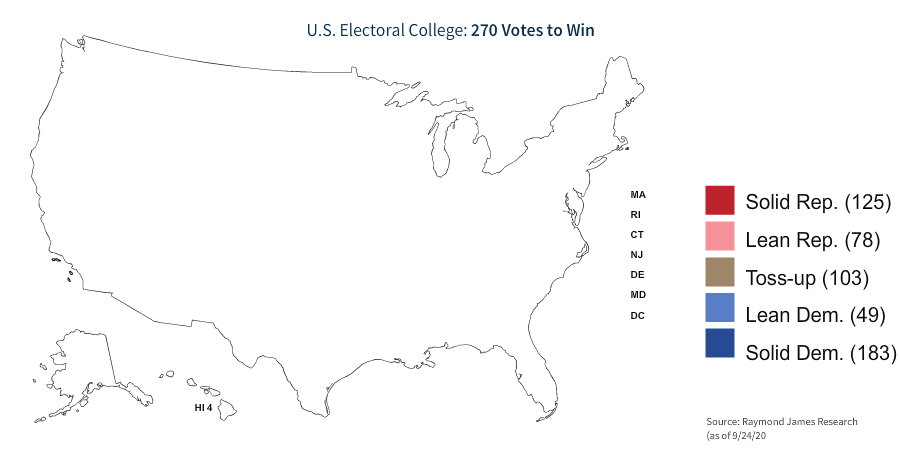
Swing States, Mail-in Votes and North Carolina's Importance
Washington Policy Ed Mills explains that, while many absentee and mail-in ballots will have been cast in advance, we may not have a finalized outcome on Election Day night.
COVID-19 has set a “new normal” in many aspects of life, and voting methods are no exception. The need for social distancing and fears about spreading the virus have caused many voters to opt for absentee or mail-in voting methods and has inspired state and local authorities to re-think related ballot rules.
As voters request record-breaking numbers of mail-in ballots, voting procedures in 2020 have the ability to impact how long we wait before we know the results of the election, the numbers and types of people who turn out to vote, and even American confidence in the election process.
Some key considerations as we approach November 3:
We may not know the outcome on Election Day.
While some states such as Arizona and North Carolina allow ballot counting to begin before Election Day, many do not start the process until that day (including Georgia, Iowa, Maine, Michigan, Minnesota, New Hampshire, Nevada, Pennsylvania and Wisconsin). Additionally, many states accept mail-in ballots received after Election Day that are postmarked by a certain deadline – and even more states than usual are doing so in 2020. For example, Ohio accepts ballots received up to 10 days after Election Day if they are postmarked by November 2.
All eyes are on the battleground states.
In the presidential race, Arizona, Florida, Michigan, North Carolina, Pennsylvania and Wisconsin are seen as potential toss-ups. Remember that 270 electoral votes are needed to secure the presidency and that all states except for Maine and Nebraska (who follow a district-level system) follow a “winner-takes-all” approach to delegating electoral votes.
Pay particular attention to North Carolina.
One early state that does count ballots before Election Day is North Carolina. We expect that most of the state’s absentee ballots, early voting and Election Day results will be available election night. If it looks like Democratic candidate and former vice president Joe Biden will win North Carolina and Democrats will carry the Senate race there – recall that this is a battleground state – those results suggest an increased likelihood of an overall Democratic sweep.
An “acceptable” ballot varies by state.
What counts in one state could be rejected in another. Some states have stricter requirements, such as requiring witness signatures or copies of IDs. Conversely, several states have relaxed their policies because of the virus – for example, Oklahoma usually requires notarization of absentee ballots, but will not this year.
Democrats lead in early mail-in voting enthusiasm in swing states.
It’s still extremely early in the race, very limited data is available and polls suggest that more Republicans plan to vote in-person than Democrats. However, preliminary numbers show that, on average, far more registered Democrats have already cast ballots in the 2020 general election by mail than Republicans.
Senate odds favor Democrats, but the race remains highly fluid.
We continue to foresee Democrats retaking the Senate. The clearest path for Democrats to flip control is with a 50-50 split and a tie-breaking vote from Vice President Kamala Harris. The passing of Justice Ruth Bader Ginsburg and the Senate’s process to confirm a new Supreme Court justice will also play a significant part in electoral dynamics. However, we are still early in the process, and there are many developments still ahead – a nomination, hearing and final votes cast by individual senators.
National electoral trends influence Senate races, but individual races may surprise.
Recent presidential-year elections have shown that split-ticket voting is becoming rarer in today’s politically polarized environment and as individual state races take on increased national significance in determining the balance of power in the Senate. However, some races will still be influenced by idiosyncratic factors that can lead to divergent outcomes for a state’s preference for Senate and president. We see Arizona, Maine and North Carolina as potential locations for split presidential and Senate results.
All expressions of opinion reflect the judgment of Ed Mills and are subject to change.

